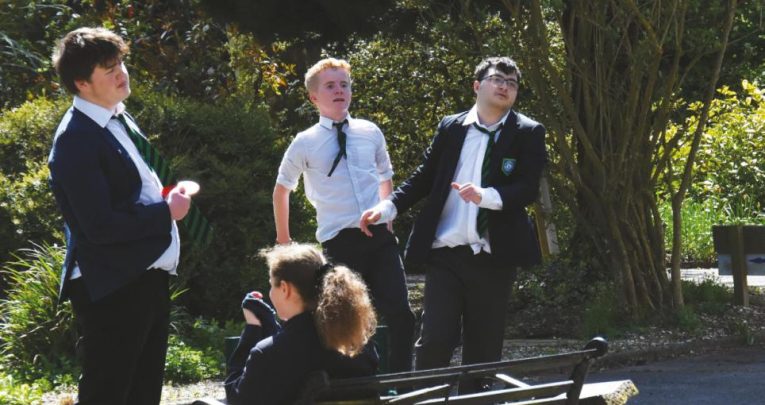Why this Special School has an Unbroken Record of University Entries for its Leavers

Callum Fauser journeys to the East Anglian countryside and sees how a special school with an unbroken record of university entries for its leavers goes about things a little differently…

- by Callum Fauser
- Editor of Teach Secondary magazine

Located in Brettenham, a small village just outside Ipswich, Centre Academy East Anglia is every inch a rural school. Surrounded on all sides by fields, and situated adjacent to the small parish church of St Mary’s, it’s a quiet, peaceful location that looks positively idyllic on the sunny spring day of my visit.
It’s one of two schools run by Centre Academy, the other being a none-more-urban site in the London borough of Battersea. Both are through schools, admitting pupils between the ages of 8 to 19 with a range of learning challenges that include dyslexia, ADHD and speech and language needs. The East Anglia site additionally has a pre-prep programme for pupils aged four to seven.
Three distinctions
According to Centre Academy’s principal and CEO, Dr Duncan Rollo, the school is unique in three fundamental ways, beginning with the age range of its pupils. “We’ve always taken children from a very young age – we’re licensed to go as low as age 4 and as high as 19,” he explains. “That’s because one of the most difficult things these children face is anxiety – and one of the things that commonly prompts the greatest amount of anxiety in a SEN child is changing schools.”
The second point of difference is that Centre Academy doesn’t ‘specialise’ in a particular learning challenge or need in the traditional sense. Instead, it embraces the modern trend in SEN provision towards identifying a primary concern and potentially one or two secondary concerns, but goes further by building as detailed a picture as possible of each child’s particular combination of challenges and needs.
“If you have the ability to deal with a child who’s on the autistic spectrum, but you’re not able to deal with an autistic child who also has dyslexia, then you’re not going to be doing the job that’s needed.” says Dr Rollo. “A lot of teachers at other schools might think our staff are fortunate, in that they have only four or five kids within a class. That assumes those kids will be marching in lockstep, but they’re not. Our teachers are expected to do a lot of juggling and individualising.”
The final, and perhaps most significant difference is the school’s divergence from the rest of country in terms of its further education provision. Instead of studying A Levels, Centre Academy students take a two-year version of the American High School Diploma.
When the school first opened at its London site in the early 2000s (the East Anglia site was opened in 2010), it adopted the High School Diploma to give its students a post-GCSE means of studying for an FE qualification recognised by UK universities without having to sit examinations.
Based around a system of continual assessment, students earn credit for completing various forms of coursework across a mix of subjects, from writing essays to carrying out research and completing art projects, and must exceed a certain grade point average in order to pass.
There’s typically a primary focus on English, maths, humanities, science and foreign languages (with the latter requirement occasionally waived for some students), after which students are free to choose from a selection of other additional subjects, such as art, law, psychology, ICT and PE.
“Exams don’t reflect our kids’ abilities because of the aforementioned anxiety,” Dr Rollo observes. “It’s not fair on our kids, because it’s the one area where they have real difficulty competing.” Moreover, he notes, it’s an approach that’s been vindicated thus far: “There’s never been a student who’s earned their American diploma from us who hasn’t gone directly to university.”
Community engagement
In common with many special schools, Centre Point East Anglia has a small pupil intake that usually hovers around 45 to 50, with a 13-strong teaching staff overseeing classes of between four and six.
The school also retains a team of in-house therapists providing SLT, occupational therapy, physiotherapy and yoga instruction, who liaise closely with the teaching staff to the point of occasional team teaching.
Embarking on a tour of the grounds with Kim Salthouse, Centre Academy’s head of school, we move from the rabbit warren of the main administrative building – a one-time rectory, all narrow, winding corridors, connecting passageways and exposed beams – outside and towards the school’s modular classrooms, along a pathway that runs past sun-dappled trees and a large pond.
As we pass groups of pupils enjoying an unseasonably warm lunch break, Mrs Salthouse explains how the school’s managed to form close links with the local community in Brettenham. Each week, one of the school’s daily meetings takes place in the church next door.
Centre Academy pupils have participated in art shows organised by the villagers and sometimes helped them with gardening and other tasks. More unusually, the local Fire Service assists the school with the climactic set piece of its annual prize day each summer, whereby a dilapidated caravan is detonated in a controlled explosion and pupils put out the smouldering remains, working as a team to operate firefighting equipment.
Arriving at one of the classrooms, we poke our heads round the door and find a lively biology class in full swing, about to embark on a lesson exploring some of the ways in which the process of conception and pregnancy can result in complications.
The pupils represent a mix of lower secondary age groups, illustrating a point Mrs Salthouse had made to me earlier: “We don’t group according to age. Instead of having year groups, we group according to ability and level of preparation, with the result that the kids are able to work with peers at the same level.”
Honest assessment
Back in the main building, I ask Dr Rollo what advice he would give to mainstream settings for supporting their own pupils with SEN. “They need to start looking at exactly what they’re doing, and assessing honestly whether it’s successful,” he replies.
“To me, the big question is what do children with SEN in mainstream schools leave with? Where they go? What do they do? We need to come up with a better, fairer system of assessing these kids. What many assume is that they’re stupid – and they’re not.”
Much of what Dr Rollo describes, and much of what the school does, is only possible due to its limited size, which he readily acknowledges, before pointing out that broader changes in the education system haven’t helped.
“I think a big problem is that we’ve done away with middle schools. Children go from these little schools straight into these big senior settings. In many cases, later therapies and interventions could have been conducted much more efficiently in a smaller setting, but that’s no longer the case.
“In any good school, children shouldn’t just be getting an education, but also coping skills. How do you cope with your dyslexia? Your ASD? We can’t cure those things, but we can show a child how to successfully live with them.”
What we do
Head of school, Kim Salthouse, describes Centre Academy’s approach to classroom practice
“We encourage the idea of the ‘reflective practitioner’. Even more than in mainstream schools, our teachers must be able to look back on their lessons with regards to what went well, what went badly and how they can improve.
With our children, you never know if something’s going to work or not. One of the best things I’ll see is when a teacher turns round to a class and says, ‘This isn’t working – we’re going to do something else.’ Because if something’s not working on any given day, you’ll lose the children immediately. We have to be flexible.
We previously had one young man who wasn’t able to sit down and work. Elsewhere, he would have been in trouble immediately. Here, our response was ‘Okay – sit down when you’re ready to.’ In five minutes he’d be sat down, completing his tasks. Time had to be allowed for him to process the teacher’s request, think about it and calm down.”
Find out more at centreacademy.net.










